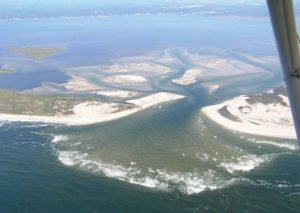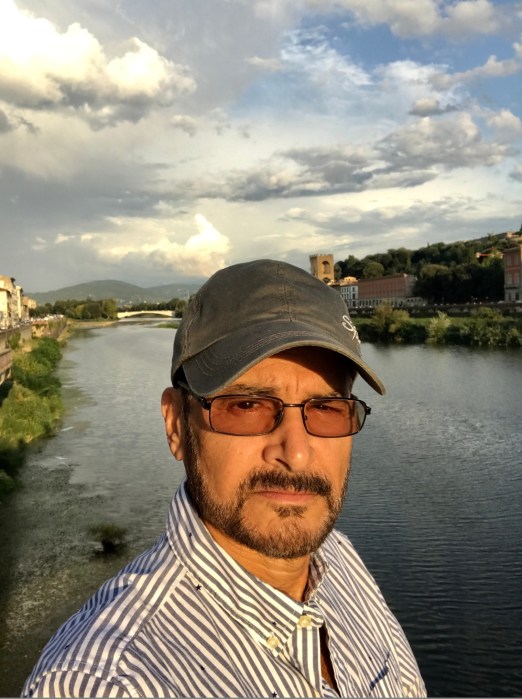VOBEC Brings Marshall Brown for Environmental Awareness Day
By Anika LanserSaturday, Aug. 19 marked the celebration of the 11th Annual Environmental Awareness Day. Sponsored by Ocean Beach Community Fund and hosted by Village of Ocean Beach Environmental Commission (VOBEC), the event features a different guest speaker each year. This year, Marshall Brown, president and co-founder of Save the Great South Bay, spoke about the water crisis in our area.VOBEC Co-Chair Camille Guigliano introduced Brown, mentioning his efforts to preserve the Great South Bay on local, state, and federal levels, along with his livestream program “Water Matters.” Brown began Save the Great South Bay shortly after his 35th high school reunion held 12 weeks before Hurricane Sandy, where he and classmates lamented the current state of the bay. He noted, “After Sandy, membership exploded. It showed us just how vulnerable we are.” To begin, Brown pinpointed several key causes of degradation of the health of the bay. “In 1976, 40 percent of the bay’s waters were filtered everyday by clams. When it tipped below 40, the bay went into a death spiral,” Brown said. Without more of the water filter fed, algal blooms obscured the water, making it difficult for seagrasses to grow and destroying habitats for shellfish and other wildlife.A key trigger for algal blooms is excess nitrogen, Brown noted. He mentioned several types: brown tide, rust tide, mahogany tide, and red tide – all of which can be seen in various places around Long Island. Brown singled out red tide as one algal bloom deadly for shellfish.But where does the nitrogen come from? Brown’s statistics show that the majority, 55 percent, comes from wastewater. Another 15 percent comes from fertilizer and 30 percent from atmospheric deposition. Brown argued, “Nitrogen levels in groundwater are increasing.”One prominent source of nitrogen in the bay is Long Island’s wastewater infrastructure. Brown discussed replacing 209,000 cesspools, a project to which $380 million has been allocated already and another $2 billion is expected to be allocated. According to Brown, this process would remove about 15 percent of the nitrogen in groundwater, an amount he deemed significant but still not enough.Another solution might be mini sewage treatment plants in yards. The technology is relatively new; about 200 have been installed this year, and another 200 will be installed in the coming year. “The cost to install these is going to be really high. We wouldn’t see any change in 10 years. They would still be building them,” Brown stated. The amount of space required for the treatment plants is another factor in whether they could be useful for reducing the amount of nitrogen in wastewater.This problem is fairly prominent on Fire Island where Brown estimates there are anywhere from six to eight thousand cesspools installed. The sewage treatment plants in each yard wouldn’t work in a Fire Island community, Brown pointed out, due to the seasonal nature of the residents. “They require year-round use,” he noted.Brown then went on to discuss several campaigns of Save the Great South Bay. The Creek Defender Program being one. Its purpose is to clean and preserve the 42 creeks that flow into the Great South Bay. Brown stated, “If you want to heal the bay, you have to start with the mainland and everything flowing in from there.”In addition the I Love Long Island campaign works to educate lawn owners on reducing the use of high-nitrogen lawn fertilizers and pesticides. “We need to reinvent the suburban lawn,” Brown said. The campaign places an emphasis on bay-friendly lawns, with the understanding that runoff from lawns after rainstorms and the like means that ultimately the chemicals used on lawns around Long Island eventually make their way into the bay. Additionally he called for the use of native plantings and a decreased use of fertilizers and pesticides, along with an emphasis on water conservation.The last main campaign of the organization is oyster cultivation. Though Brown is realistic about the need for cleaner water in the bay before the project can begin, he also sees great potential in shellfish restoration due to their ability to filter water at high rates. Brown estimated that 5,000 acres of oyster farms would manage the high nitrogen rates by 147 percent. Similar projects have been undertaken in New York City and Chesapeake Bay. “For every foot of water clarity, you gain 2 to 4 percent in property values,” Brown was sure to note.A lively question and answer session rounded up the end of Brown’s talk. Brown addressed concerns and questions about the breach on Fire Island created by Hurricane Sandy. “It appears to be closing. It’s a highly dynamic system,” he noted. Brown felt that it would be okay for the breach to close, but that a manmade breach should be created near the Fire Island Lighthouse instead. He argued that the Army Corps of Engineers should take on this project, but understands that this is unlikely to happen. Brown was critical of the Army Corps, saying, “The projects they want to take on aren’t geared towards habitat restoration.”Another attendee asked about the prominence of bulk heading on the shores of the Great South Bay. Brown was adamant: “Bays need shores.” He discussed the importance of a natural shoreline for creatures like horseshoe crabs and terrapins that need to be able to move onto the shore to lay their eggs. Brown noted that in some cases bulk heading has been brought down by marsh restoration.When a resident asked how Fire Island National Seashore could have allowed this to happen to the Great South Bay, Brown’s answer was insightful and his mood became almost defeated. He answered simply: “Major political donors are builders.” He noted the economic structures that convince politicians that construction and expansion are better for the economy and create jobs, and that this often happens at the expense of our natural environment.Brown’s lecture gave the audience several different ways to get involved and help Save the Great South Bay. “As with anything, we have a long way to go,” he said in closing.
To begin, Brown pinpointed several key causes of degradation of the health of the bay. “In 1976, 40 percent of the bay’s waters were filtered everyday by clams. When it tipped below 40, the bay went into a death spiral,” Brown said. Without more of the water filter fed, algal blooms obscured the water, making it difficult for seagrasses to grow and destroying habitats for shellfish and other wildlife.A key trigger for algal blooms is excess nitrogen, Brown noted. He mentioned several types: brown tide, rust tide, mahogany tide, and red tide – all of which can be seen in various places around Long Island. Brown singled out red tide as one algal bloom deadly for shellfish.But where does the nitrogen come from? Brown’s statistics show that the majority, 55 percent, comes from wastewater. Another 15 percent comes from fertilizer and 30 percent from atmospheric deposition. Brown argued, “Nitrogen levels in groundwater are increasing.”One prominent source of nitrogen in the bay is Long Island’s wastewater infrastructure. Brown discussed replacing 209,000 cesspools, a project to which $380 million has been allocated already and another $2 billion is expected to be allocated. According to Brown, this process would remove about 15 percent of the nitrogen in groundwater, an amount he deemed significant but still not enough.Another solution might be mini sewage treatment plants in yards. The technology is relatively new; about 200 have been installed this year, and another 200 will be installed in the coming year. “The cost to install these is going to be really high. We wouldn’t see any change in 10 years. They would still be building them,” Brown stated. The amount of space required for the treatment plants is another factor in whether they could be useful for reducing the amount of nitrogen in wastewater.This problem is fairly prominent on Fire Island where Brown estimates there are anywhere from six to eight thousand cesspools installed. The sewage treatment plants in each yard wouldn’t work in a Fire Island community, Brown pointed out, due to the seasonal nature of the residents. “They require year-round use,” he noted.Brown then went on to discuss several campaigns of Save the Great South Bay. The Creek Defender Program being one. Its purpose is to clean and preserve the 42 creeks that flow into the Great South Bay. Brown stated, “If you want to heal the bay, you have to start with the mainland and everything flowing in from there.”In addition the I Love Long Island campaign works to educate lawn owners on reducing the use of high-nitrogen lawn fertilizers and pesticides. “We need to reinvent the suburban lawn,” Brown said. The campaign places an emphasis on bay-friendly lawns, with the understanding that runoff from lawns after rainstorms and the like means that ultimately the chemicals used on lawns around Long Island eventually make their way into the bay. Additionally he called for the use of native plantings and a decreased use of fertilizers and pesticides, along with an emphasis on water conservation.The last main campaign of the organization is oyster cultivation. Though Brown is realistic about the need for cleaner water in the bay before the project can begin, he also sees great potential in shellfish restoration due to their ability to filter water at high rates. Brown estimated that 5,000 acres of oyster farms would manage the high nitrogen rates by 147 percent. Similar projects have been undertaken in New York City and Chesapeake Bay. “For every foot of water clarity, you gain 2 to 4 percent in property values,” Brown was sure to note.A lively question and answer session rounded up the end of Brown’s talk. Brown addressed concerns and questions about the breach on Fire Island created by Hurricane Sandy. “It appears to be closing. It’s a highly dynamic system,” he noted. Brown felt that it would be okay for the breach to close, but that a manmade breach should be created near the Fire Island Lighthouse instead. He argued that the Army Corps of Engineers should take on this project, but understands that this is unlikely to happen. Brown was critical of the Army Corps, saying, “The projects they want to take on aren’t geared towards habitat restoration.”Another attendee asked about the prominence of bulk heading on the shores of the Great South Bay. Brown was adamant: “Bays need shores.” He discussed the importance of a natural shoreline for creatures like horseshoe crabs and terrapins that need to be able to move onto the shore to lay their eggs. Brown noted that in some cases bulk heading has been brought down by marsh restoration.When a resident asked how Fire Island National Seashore could have allowed this to happen to the Great South Bay, Brown’s answer was insightful and his mood became almost defeated. He answered simply: “Major political donors are builders.” He noted the economic structures that convince politicians that construction and expansion are better for the economy and create jobs, and that this often happens at the expense of our natural environment.Brown’s lecture gave the audience several different ways to get involved and help Save the Great South Bay. “As with anything, we have a long way to go,” he said in closing.































